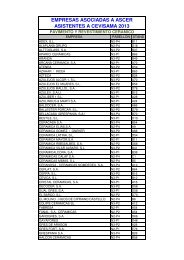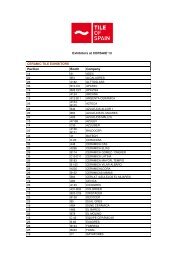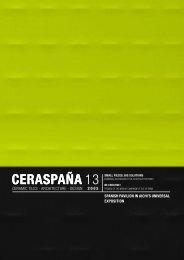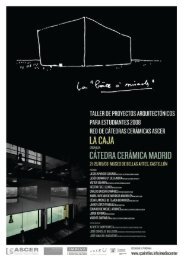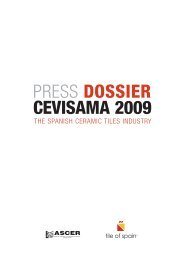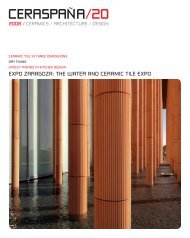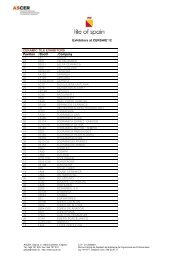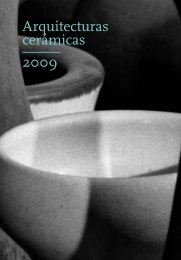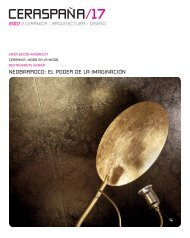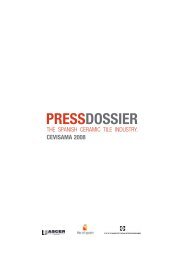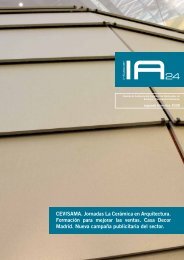You also want an ePaper? Increase the reach of your titles
YUMPU automatically turns print PDFs into web optimized ePapers that Google loves.
The “wenge Tablet” series is part <strong>of</strong> Spanish manufacturer Zirconio’s Alaska collection. Made in a single 33.3x67.1cm format this porcelain stoneware series is highly valued for the warmth itexudes.The current generation <strong>of</strong> ceramic woods is already available in specialistretail outlets and is practically indistinguishable from wood – not just visuallybut in every other sense too. Even the experts have doubts when it comes toidentifying by feeling or walking on this material, whether it is wood orceramic. In their continual search for new challenges ceramic parquet istherefore one <strong>of</strong> the “ongoing successes” for the product developmentdepartments <strong>of</strong> a great many Spanish manufacturers.Made in the classic 45x45cm tile format,Azulejos Mallol’s new Nogal (Walnut) collectionboasts the expressive surface structure <strong>of</strong>vibrant parquet flooring.Today’s consumers want their immediate surroundings to give them a sense<strong>of</strong> warmth and security and wood – floorboards and parquet – is a commonchoice. Ceramic is in many respects, however, superior to wood flooring.The latest generation tiles can combine aesthetic features with the mostdemanding technical attributes specified for floor coverings because they arelow maintenance, very durable, easy to clean and disinfect, slip-resistant,incombustible and safe in a fire. Also, visual or tactile differences can beincorporated so as to provide signposting and their structure can be adaptedto make different shapes and sizes, thus making them suitable for use on anysurface. In addition to these properties, tiles also <strong>of</strong>fer other advantages.They do not carry electrostatic charges, provide heat and sound insulation,have no intrinsic smell do not take on external odours, are environmentally04CERASPAÑA
friendly and recyclable and installation systems are both flexible and efficient.Equally, ceramic is an excellent heat conductor when combined withunderfloor heating.The high fracture co-efficient and abrasion resistance – to clearingproducts and chemical agents – <strong>of</strong> some kinds <strong>of</strong> tile such as porcelainstoneware makes ceramic parquet suitable for use in commercial andindustrial high traffic areas, where it is essential to use a covering that canwithstand intense pedestrian and vehicular traffic. Curvilinear edges,sophisticated designs and logos created with laser or waterjet technologymake it possible to communicate corporate identities or local emblems thatcan personalise any surroundings. Ceramic wood floors can also be usedin urban exteriors (avenues, parks, promenades etc.), using the versatility<strong>of</strong> tiles to create social, interactive spaces that integrate perfectly into theirenvironment.The smooth textures and graining <strong>of</strong> the products currently on the marketmean that all kinds <strong>of</strong> woods can be replicated, with notable improvementsto the technical characteristics and appearance <strong>of</strong> the originals. Far frombeing a pale imitation <strong>of</strong> wood, the warm sheen and lifelike graining <strong>of</strong>today’s ceramic parquet have turned this easy maintenance, long-lastingproduct into a warm covering that can project a broad range <strong>of</strong> sensations.This is, in short, a covering that exudes comfort, convenience and warmth.Another aspect <strong>of</strong> ceramic tiles is that they <strong>of</strong>fer the consumer noble and exoticwoods at prices far lower than those <strong>of</strong> the genuine article. Nor should we forgetthe problem <strong>of</strong> deforestation caused by the huge demand for tropical wood.The Andorra collection by Real Cerámica, available in 45x45cm and 14.8x45cm formats, isappreciated for the warmth <strong>of</strong> its walnut, pine and oak finishes.Keros Cerámica’s 14x50cm Madera (Wood) series, reflects the warmth <strong>of</strong> parquet in four elegant colours: honey, earth, oak and mahogany.CERASPAÑA05
Colorker’s “Parquet“ series is available in fourattractive wood colours and a single 15x60cmformat. The inspiration for these stoneware tileswas natural wood from a number <strong>of</strong> differentsources. Made to withstand frosts, this series<strong>of</strong> rectified tiles is equaly suitable for exteriorand interior use.Lastly, calibrating the tiles, or in other words rectifying their edges perfectly,means they can be installed practically joint-free, thereby avoiding wide gapsbetween them that would otherwise spoil their overall appearance. Theextensive range <strong>of</strong> formats includes tile sizes (15x15cm, 30x30cm,40x40cm, 50x50cm, 30x60cm, 60x120cm, 50x100cm etc.) as well as thetraditional floorboard measurements (15x50cm and 15x110cm). This meansthat ceramic parquet can be used in many modular variations, affording agreat many more design options.With its “Forest” glazed stoneware series, Azteca Cerámica has produced an indestructible 41 x 41cm floor covering inspired by the warm look <strong>of</strong> parquet.06CERASPAÑA
“MOULDING ASSEMBLING DESIGNINGCERAMICS IN ARCHITECTURE”This first book produced by ASCER – in conjunction with publishers Actar –was launched last February at the same time as CEVISAMA, the internationaltile exhibition held in Valencia. The book examines the fruitful, fascinatingrelationships between ceramic tiles and architecture.It also reviews the projects developed at the Department <strong>of</strong> Ceramic <strong>Tile</strong>Studies at the International University <strong>of</strong> Catalonia’s Advanced School <strong>of</strong>Architecture, which opened in October 2004 and is a forum where architectsand manufacturers <strong>of</strong> ceramic materials can meet and work together. The title<strong>of</strong> the Association’s first book specifically on architecture alludes to threedifferent aspects <strong>of</strong> tiles that make today’s products different:Moulding. This concept suggests that the new formats, textures and shapesthat are available influence the new and original applications for ceramic tilesthat emerge.Assembling. The enormous variety <strong>of</strong> sizes available means that tiles can becombined in thousands <strong>of</strong> different ways, so that tiles and tile systemsbecome a means for giving a fresh interpretation to art and design.Designing. Along with their quality and high technical specifications, ceramictiles <strong>of</strong>fer all manner <strong>of</strong> design options, using anything from the traditional tothe most avant-garde tiles.A NUMBER OF LEADING ARCHITECTS HAVE CREATED ANANTHOLOGY OF THEIR MOST REMARKABLE PROJECTS IN ABOOK ON APPLICATIONS FOR CERAMIC TILES IN ARCHITECTUREPUBLISHED BY THE SPANISH CERAMIC TILE MANUFACTURERS´ASSOCIATION (ASCER). THE BOOK CAPTURES THE CUTTINGEDGE NATURE, CURRENT DESIGN AND QUALITY OF CERAMICTILES PERFECTLY.The book looks at work by more than 30 leading international architects thatuses ceramic tiles as a key element and to create a point <strong>of</strong> difference for theparticular project. Some <strong>of</strong> the most outstanding projects, all <strong>of</strong> which aredescribed by the architects themselves, include:The Casa de Cascais, by Eduardo Soto de Moura.The Renovation <strong>of</strong> Santa Caterina Market in Barcelona, by EnricMiralles and Benedetta Tagliabue (EMBT Arquitectes).The Spanish Pavilion at the 2005 Aichi Expo in Japan, by AlejandroZaera-Polo and Farshid Moussavi (Foreign Office Architects).La Manduca Restaurant in Madrid, designed by Francisco Mangado.Casa 4C in Barcelona, by Jaume Bach.The New Art Gallery and Public Square in Walsall, England, designedby Caruso St. John Architects.The Peñíscola Conference Centre, by Paredes Pedrosa Arquitectos.Café Una in Viena, by Lacaton Vassal Architects.La Ricarda by Antonio Bonet and Fernando Álvarez.As well as remarkable works <strong>of</strong> architecture that have used ceramic tiles, thebook also includes a number <strong>of</strong> informative articles on tiles that aim toeducate the reader as to the new, original products that the ceramic tileindustry has to <strong>of</strong>fer to the world <strong>of</strong> architecture today.CERASPAÑA07
Casa Decor Madrid 2006“ CERAMICSCOULD TELLTHE HISTORYOF THE WORLD”INTERVIEW WITH TERESA SAPEY, DESIGNER OF THE CERAMIC TILE SPACE AT CASADECOR MADRID 06Teresa Sapey demonstrated at the latest Casa Decor Madrid thatceramic tiles are a key element <strong>of</strong> architecture and interior design.She created interior and exterior spaces where, in an innovative,cutting edge conception, the latest trends in design blended with amaterial that <strong>of</strong>fers limitless possibilities. The initiative for the projectcame from ASCER and the Institute for Ceramic Design andApplications (IDAC), who both made it possible, and it was staged in the“100% CERÁMICA” space. Sapey dedicated the display to the memory<strong>of</strong> her father and her talent, training and considerable experiencemeant that the rooms were truly thought provoking. The displayaddressed the issue <strong>of</strong> the prohibition on smoking in public spaces.Do you think that ceramic tiles are a cutting edge material today?No doubt about it. You only need to look at the huge number <strong>of</strong> new buildingsthat use the material in their interiors, in rooms that are not very traditionalsuch as living rooms, master bedrooms and dressing rooms, and on theexteriors too as cladding for the façades.Also, the construction industry is making a serious commitment to ceramictiles that is beginning to be evident, for instance, in the specialist decorating,interior design and construction exhibitions that make a major feature <strong>of</strong>ceramic tiles most years. Awards and other events <strong>of</strong>ten include ceramictiles too, which gives an indication <strong>of</strong> their market penetration and themedia’s interest in them.Why ceramic tiles and not other materials? What advantages doesceramic <strong>of</strong>fer in your opinion?Ceramics could tell the history <strong>of</strong> the world…this is a material that is rich intextures, colours, formats and subtle variations that can be used in all sorts<strong>of</strong> ways…for making furniture, on walls, on ro<strong>of</strong>s, on floors and on façades.It can give the architect a true sense <strong>of</strong> freedom.Casa Decor Madrid 2006Would it be fair to say that you yourself have only discovered ceramicas a material recently?Ceramic has the advantage <strong>of</strong> having a foot in both camps, as it were: it is atonce cutting edge and traditional. It was around all the years <strong>of</strong> my trainingand appeared in subsequent projects too. Not long ago for instance I led aproject to restore a masía (traditional Catalan country house) in Cadaqués.08CERASPAÑA
The starting point was to preserve all the old ceramic, adapting it to the hereand now.restrictions. I personally feel that people should be provided with as muchinformation as possible to enable them to make free choices that reflect theirneeds, wishes and, <strong>of</strong> course, their duties.What have you tried to reflect in your work?I suppose some sectors <strong>of</strong> the industry would dub me an iconoclast. Nowthat I have a few years <strong>of</strong> work under my belt I can say that there is acommon thread that runs through every project I undertake: the search forfreedom…and to be able to express that! Ceramic tiles have provided amedium for that expression.Equally, architecture and interior design can also be a means <strong>of</strong>communication and it is in this sense that we want to claim design as a “toolfor expressing opinions”. What I mean by this is that a space can express anopinion; it can bring an issue out into the open and prompt a democraticdebate. We do not necessarily take a position for or against, we simplyexpose a very current issue and invite people to reflect upon it.How did you feel when ASCER invited you to design the “100%Cerámica” space?I was absolutely thrilled. I could not have felt any other way. I love my work.I am very lucky to receive the support I need to make a project like this cometogether.Could the ASCER/Ceramics space at this last show be defined as aspace that is representative <strong>of</strong> Teresa Sapey? If so, why?Unquestionably yes, you only needed to look at it to know that it was.Tell us about your most recent projects.The most recent was the one at Casa Decor Madrid ’06 using ceramic tiles.I am also very pleased with how well Isolée, a concept store on Calle Infantas(Madrid), is working. We are also working on a project for Mandarina Duckand are still designing homes and <strong>of</strong>fices. As to what is next, I would like tomake garden furniture using ceramic tiles, for example.Why have you brought the issue <strong>of</strong> tobacco into your project?Who is talking about tobacco? I think that the suggestion <strong>of</strong> smoke is veryrepresentative as a symbol… Knowledge could be represented as smokeinhaled and then exhaled filtered. There is currently an interesting debategoing on, a growing controversy even over whether or not to stop smokingthat addresses freedom to choose as a separate issue to prohibitions andCasa Decor Madrid 2006TERESA SAPEYBorn in Cuneo in Italy in 1962 but settled in Madrid, Sapey has a doctorate in Architecture and Fine Arts. Shecombines both disciplines with interior design to perfection, a mix that has created a hugely successful career –developed in <strong>Spain</strong> but with the evident influence <strong>of</strong> the Italian school – and has placed her name at the cuttingedge <strong>of</strong> design. Ceramic tiles are one <strong>of</strong> her constants and by using them she demonstrates that the material hasbeen adopted by the new trends. Since the 1990’s her career has been split between Barcelona and Madrid, inwhich latter city she runs her own architectural practice, the Estudio de Arquitectura Teresa Sapey.Her CV features awards such as the International Competition prize she won for the “portable bar” she designedfor Absolut Vodka and the National Competition prizes she won for her refurbishments <strong>of</strong> the Tandem and Mc Cann-Erikson advertising agencies’ <strong>of</strong>fices in Madrid.She has also designed the Custo shops in Barcelona, Madrid, Paris and Milan and the company’s franchises in LasVegas, Beverly Hills, Dallas and Salamanca, as well as objects for Walt Disney and interiors for homes, schools, artgalleries and hotels.CERASPAÑA09
SHOWROOM NEW TRENDSESTUDIO CERÁMICO MORELLA SERIESThe Morella series created by Estudio Cerámico consists <strong>of</strong> a range <strong>of</strong> specialpieces such as mouldings, edgings and drip plates, all in shades <strong>of</strong> stone colours.Estudio Cerámico specialises in developing special pieces and is able to focus onall aspects <strong>of</strong> production as it has total control <strong>of</strong> the manufacturing process fromdesigning and making the moulds and stamps to the special sponged, handpaintedor screen-printed finishes that are applied.www.estudioceramico.es · marketing@estudioceramico.esPAMESA TIBET SERIESPamesa’s inspiration for the design <strong>of</strong> the Tibet series was trachyte, a rock <strong>of</strong> volcanicorigin. Part <strong>of</strong> the Porcelánico Compactto Pedra collection Tibet tiles are available in50x50 and 30x60cm formats and with a semi-polished or natural finish. This is aseries whose broad range <strong>of</strong> colours – Blanco (White), Marfil (Ivory), Arancio(Orange), Marrón (Brown), Tabaco (Tobacco), Gris (Grey) and Negro (Black) is asinteresting as its subtle graphic design. www.pamesa.com · export@pamesa.comAZULEJOS MALLOL TITANIO SERIESThe outstanding feature <strong>of</strong> the Titanio series by Mallol is the variety <strong>of</strong> colours oneach tile, with several metallic reflections that change the tile’s appearanceaccording to the angle from which one looks at it. These 40x60cm glazedporcelain tiles are ideal both for decorating interiors and cladding façades. Theseries is available in two finishes: Titanio Ocre (Titanium Ochre) and Titanio Óxido(Titanium White). www.azulejosmallol.com · mallol@azulejosmallol.com10CERASPAÑAAZUVI SHAPE SERIESThe success <strong>of</strong> Azuvi’s Shape series derives from the original shape <strong>of</strong> the tiles andthe relief on their surface that makes them look like facebrick. As these are porcelainstoneware tiles and thus <strong>of</strong>fer high resistance and durability they can be used forinteriors and exteriors. Equally, they are though-coloured and slightly mottled, makingthem more natural-looking. Shape are available in a single 31.6x50cm format andin Ocre (Ochre), Rojo (Red), Gris (Grey), Beige, Marengo, Café (C<strong>of</strong>fee), Blanco, Negro(Black), Desert, White and Noce (Walnut). www.azuvi.com · azuvi@azuvi.com
SHOWROOMITALGRES CALGARY SERIESItalgres is launching a porcelain stoneware series called Calgary in themanufacturer’s new 45x67cm format. Calgary is available in very s<strong>of</strong>t, neutralshades – Marfil (Ivory), Beige and Gris (Grey) – and 5x5cm mesh-mounted mosaiccomplements the series. The tiles are manufactured using 8 rollers <strong>of</strong> 144cm,making it virtually impossible to find two identical tiles, just the same as withnatural stone. www.italgres.es · italgres@italgres.esCERÁMICAS L’ALCALATÉN ÓXIDOS SERIESCerámicas l’Alcalatén is launching the Óxidos series. Reflecting one <strong>of</strong> today’scurrent decorative trends, the series reproduces the metallic, oxidised reflections<strong>of</strong> corten steel. The series is being made in porcelain stoneware and in largeformats: 30x60 and 45x45cm. The tiles are available in elegant shades <strong>of</strong> darkgrey with very avant-garde metallic highlights.www.alcalaten.com · ceramicas@alcalaten.comHISPAGREX CLÁSICA SERIESALAPLANA JOY SERIESManufacturer Alaplana is launching a new series called Joy in response to one <strong>of</strong> the most currenttrends in the built environment: the return to rich, happy colours. This wall tile series comes in a27x37cm format and a palette <strong>of</strong> very strong, vibrant colours: Blanco (White), Amarillo (Yellow),Rojo (Red), Verde (Green), Lila (Lilac), Naranja (Orange), Gris (Grey) and Azul (Blue). The surface <strong>of</strong>these tiles shows a slight relief and with the finish Alaplana has restored the shine that is typical<strong>of</strong> ceramic colours. www.alaplana.es · alaplana@alaplana.esHispagrex has combined geometric shapes in an imaginative wayin its Clásica extruded stoneware series and created harmonioussets <strong>of</strong> tiles. The colours <strong>of</strong> the tacos and stars that have beenadded to the series – Rojo (Red), Amarillo (Yellow), Verde (Green),Azul (Blue), Marrón (Brown) and Blanco (White) – make it evenmore versatile and open up a whole realm <strong>of</strong> possibilities.Hispagrex set great store by combinations <strong>of</strong> colours and multipleshapes and formats: paving stones, octagons, pentagons andsconces that mean the consumer can create personalised roomswithin the overall design <strong>of</strong> their home. hispagrex@hispagrex.esCERASPAÑA11
SHOWROOMINALCO FOREST SERIESInalco’s Forest series is manufactured using digital iPLUS technology. Part <strong>of</strong> theMaderas (Woods) collection, the series is available as 33x100cm and 32x99cmwall tiles and 33x33cm and 32x32cm porcelain floor tiles. The tile have a strikingundulated finish that gives a space a new dimension. It is undulated tiles thatdemonstrates the possibilities for digital inkjet printing technology onto ceramic asthe entire surface <strong>of</strong> the tile can be decorated, including areas <strong>of</strong> high and lowrelief. The Forest series comes in three shades: Miel Mate (Matt Honey), HayaMate (Matt Beech) and Wengué (Wenge). www.inalco.es · correo@inalco.esOSET FACHADAS SERIESOset is launching the Fachadas series. One <strong>of</strong> its most novel propositions,Fachadas is part <strong>of</strong> the Mineral collection. Mineral is manufactured in two sizes,15.7x15.7cm and 15.7x31.6cm, making it possible to devise very attractivegeometric combinations. The series comes in Grafito (Graphite), Musgo (Moss),Tierra (Earth) and Sal (Salt) and with trim pieces such as angles and corners tocreate perfect finishes. www.oset.es · oset@oset.esCERÁMICA DECORATIVA AICHI SERIESThe Aichi series by Decorativa comes as an extension to the Project the companyundertook to clad the Spanish Pavilion at the Aichi Expo in Japan with hexagonalceramic tiles. The series is comprised <strong>of</strong> geometric tiles that break with the classicorthogonal shape and also includes 10x10 square and 10x30cm rectangular fieldtiles. The different compositions are the result <strong>of</strong> combining variously colouredpentagonal tiles with décor tiles. The tiles are available in a range <strong>of</strong> bright colours:Blanco (White), Marrón (Brown), Naranja (Orange), Pistachio, Rojo (Red) and Turquesa(Turquoise). www.ceramica-decorativa.es · comercial@ceramica-decorativa.es12CERASPAÑA
SHOWROOMCODICER CRETA SERIESCERÁMICA ELÍAS MILENIUM SERIESThe Milenium series by Cerámica Elías exudes the warmth and natural feel that are intrinsic to more artisan styletiles. The collection spans the spectrum <strong>of</strong> the colours <strong>of</strong> the rainbow – Pizarra (Slate), Burdeos (Bordeaux), Beige,Canela (Cinnamon), Musgo (Moss), Gris (Grey) – and is available in a number <strong>of</strong> formats from 10x10 to 40x40cm.The Milenium series is recommended for interior use and the tiles’ surface has been treated to create a veryattractive aged effect. www.ceramicaelias.com · comercial@ceramicaelias.comCodicer95 is a specialist manufacturer <strong>of</strong> extrudedstoneware and has just launched the Creta series.This is a rustic stoneware product in a 33x33cmformat that comes in Beige Claro (light beige) andfor which there is a multitude <strong>of</strong> complementarydecor pieces that can be used to create a flavour<strong>of</strong> the more traditional ceramic tiling. In thephotograph the Creta field tile has been combinedwith the Palos 16x33cm border. The samecollection includes 33x33cm Corfú in AmarilloAnaranjado (Orangey Yellow) and Malta in Cuero(Hide) as well as 25x25cm field tiles in the samecolours that are named Beta (beige), Zinc (yellow)and Zitro (hide).www.codicer95.es · codicer@codicer95.esCICOGRES ZEBRANO SERIESVIVES OZZIERI SERIESThe ancient pink stone <strong>of</strong> Cerdeña has a unique, unmistakable attractiveness that Vives has captured in itsnew Ozzieri series. Made in rectified glazed porcelain the Ozzieri series is being marketed as a new, originalconcept: multi-formats. Each box contains 11 tiles in 4 different formats, finishes and colours. Theunlimited installation options will produce exceptional aesthetic results. www.vivesceramica.com ·export@vivesceramica.comCicogres has launched its Zebrano series thatreproduces natural wood but improves upon it.8x45cm skirting complements the 45x45cmstoneware floor tiles, which add the advantagesand superior features <strong>of</strong> ceramic – being easy toclean, nil maintenance, hard wearing etc. – to thecomfortable appearance <strong>of</strong> wood.www.cicogres.es · cicogres@cicogres.esCERASPAÑA13
SHOWROOMALCALAGRES COTTÍSIMO SERIESSpecialist technical porcelain manufacturer Alcalagres has launched the Cottísimoseries. Available in Blanco (White), Rojo (Red) and Beige, the series ismanufactured using the latest generation technology and boasts all the technicalfeatures <strong>of</strong> porcelain in terms <strong>of</strong> resistance, durability, nil water absorption andease <strong>of</strong> maintenance. These tiles are also smooth textured, come in evocativecolours with a hint <strong>of</strong> rusticity and are made in a single 11.5mm thick, 30x30cmformat. www.alcalagres.com · general@alcalagres.comHISPANIA CERÁMICASCORAL SERIESHispania Cerámica is introducing a new interior walltile series: Coral. Available in three formats,33.3x50, 33.3x33.3 and 45x45cm, the tiles aremade in a range <strong>of</strong> s<strong>of</strong>t, elegant shades (Sand andBeige). A selection <strong>of</strong> décor pieces such as theCoral border, the Arrecife décor and the Rio Mixmosaic complement the field tiles.www.hispaniaceramica.comglobal@hispaniaceramica.comZIRCONIO MÉRIDA SERIESMérida is a new series <strong>of</strong> large format (60x60cm) porcelain stoneware tiles from Zirconio. Mérida’s colour paletteis centred on neutral shades – Blanco (White), Negro (Black), Noce (Walnut) and Marrón (Brown) – that are easy tomix and match and are ideal for decorating rooms in line with today’s style. www.zirconio.es · zirconio@zirconio.esCERANOSA METÁLICA SERIESCeranosa has gone for metallic reflections in its Metálicawall tile series, which is being made in a 31.6x45cmformat. Colours available include Azul (Blue), Beige andÓxido (Oxide), which combine perfectly with the Rapolanostoneware floor tiles. To complete the décor Ceranosa<strong>of</strong>fers a wide range <strong>of</strong> 4.5x31cm and 5x45cm borders in anumber <strong>of</strong> different colours and designs.www.ceranosa.com · ceranosa@ceranosa.com14CERASPAÑA
SHOWROOMAPAVISA STONETECH COLLECTIONThe Stonetech collection, part <strong>of</strong> Apavisa’s Stone series, consists <strong>of</strong> naturallookinglarge format porcelain stoneware tiles. The collection is suitable for interiorand exterior applications and for façades. The photograph shows the Ardosiaseries, which is available in black and in three sizes: 60x120, 31x120 and15x120cm. www.apavisaporcelanico.com · info@apavisa.comGAYAFORES DUALIST SERIESGayafores presents the varied and colourful Dualist series. Several 20x20cmformat collections have been developed as part <strong>of</strong> this series (Art, Fantasy, Dualand Dalia – see photograph) that combine with the typical skirtings that Gayaforesmanufactures and reinvents, adapting them to the latest decorative trends,retaining their usual applications but opening up innovative design opportunities.These tiles are available in Blanco (White), Acqua, Azul (Blue), Burdeos (Bordeaux)and Naranja (Orange). www.gayafores.es · info@gayafores.esGAROGRES CANDY SERIESGarogres’ new series <strong>of</strong> porcelain stoneware tiles is characterised bycombining straight and curved edges and the manufacturer has grouped thetiles together under the name <strong>of</strong> Forma. The Candy series is a departure fromthe classic orthogonality <strong>of</strong> ceramic tiles and makes the shape <strong>of</strong> the tile itsmain feature, thereby achieving stunning visual effects. Candy comes in a33x23cm format and, being porcelain stoneware tiles, they are equally suitablefor interiors and exteriors. www.garogres.com · export@garogres.comCERASPAÑA15
THE FOUR SADDLES ARCH: GAUDIANARCHITECTURE IN THE HOME OF JAPAN’SCERAMIC ARTSIn a small sanctuary more than 10,000 kilometres from <strong>Spain</strong>, ceramic tilesand Gaudí are the object <strong>of</strong> veneration. Japan is a country <strong>of</strong> contrastsbetween ancient imperial culture and the most futuristic cutting edge. Thecity <strong>of</strong> Ebetsu on the northern island <strong>of</strong> Hokkaido is an exponent <strong>of</strong> the land<strong>of</strong> the rising sun’s age-old tradition <strong>of</strong> ceramic art. In this town, which isalso known as “the city <strong>of</strong> ceramic art”, architect Hiroya Tanaka has built the“Four Saddles Arch” or “Lily <strong>of</strong> the Valley Arch”, in honour <strong>of</strong> Hokkaidoprovince’s most emblematic flower.Constructed entirely <strong>of</strong> brick made in Ebetsu itself, clad with ceramic tiles bySpanish manufacturer Gres de Breda and held together with cement byWeber, this monument is a brilliant homage to Gaudí’s style. The sculpturestands in pride <strong>of</strong> place on a circular plaza just opposite Ebetsu’s CeramicArt Centre.The work also pays homage to proportion: it measure four metres high, fourmetres wide and four metres long. Tanaka explains that he wanted to applyan “organic geometry”, something quite unprecedented in this country, tothe monument. To do this the architect, who is Japanese by birth andCatalan by adoption, surrounded himself with a team <strong>of</strong> people who werevery familiar with the work <strong>of</strong> Antoni Gaudí, the genius <strong>of</strong> modernism. Theteam comprised Catalan master frame builder Jordi Doménech and hisJapanese assistant Taniguchi Tatsuhei.The finishing touch to the plaza, which opens onto the Ceramic Art Center,was commissioned by the Ebetsu City Council and Brickjam 2004. Tanaka,Doménech and Tatsuhei built the sculpture over 12 days, from 4 th to16 thOctober 2004, with the help <strong>of</strong> five volunteers. It was unveiled the followingday, coinciding with the 40 th anniversary <strong>of</strong> the founding <strong>of</strong> Ebetsu as a city.The work traces the shape <strong>of</strong> a hyperbolic paraboloid, one <strong>of</strong> the brilliantGaudí’s most central visual elements. For ultramodern Japanesearchitecture the shape and the complexity and novelty <strong>of</strong> using brick andceramic tiles to build it meant that it was something utterly new, unknownand avant-garde.Structurally, the sculpture consists <strong>of</strong> a brick core faced with ceramic tilesby Spanish manufacturer Gres de Breda. The lack <strong>of</strong> steel in the structure16CERASPAÑA
shows the versatility, flexibility and considerable potential <strong>of</strong> the materialsused. The arch itself is a clear example <strong>of</strong> how important ceramic tiles arein the field <strong>of</strong> construction and, given that at its thinnest point the arch isjust 65 millimetres thick, <strong>of</strong> their strength and malleability as well.All <strong>of</strong> these features must make the Four Saddles Arch <strong>of</strong> Lily <strong>of</strong> the ValleyArch one <strong>of</strong> Ebetsu’s most emblematic monuments. It is certainlyphotographed and remembered by all those who visit it. Tanaka himself hasdefined it as “original, innovative and extraordinary, with a geometricarchitectural symbolism.”The impact <strong>of</strong> this work, which is unique in Japan, has reached far beyondthe Asian country’s frontiers, making it a point <strong>of</strong> reference in both art andceramic architecture. In <strong>Spain</strong>, the Asociación Gaudí & Barcelona Club, <strong>of</strong>which Hiroya Tanaka is also a member, promotes this unusual “saddle” asan example <strong>of</strong> Antoni Gaudí’s universality and the relevance <strong>of</strong> his worktoday.Hiroya Tanaka owes his adopted Catalan status to his devotion to theCatalan genius and to the studies <strong>of</strong> modernism’s most celebratedmastermind that he carried out in <strong>Spain</strong>. In 1992 he worked on a thesistitled “Graphic Methodology: Drawings and Proportion in the Work <strong>of</strong> Gaudí”,which he defended at the Polytechnic University <strong>of</strong> Catalonia in 1992 andwhich earned him a doctorate.Tanaka is one <strong>of</strong> the world’s most knowledgeable people on Gaudianarchitecture. The Japanese expert is one <strong>of</strong> the leading researchers into thework <strong>of</strong> Gaudí and has participated in technical conferences for architects in<strong>Spain</strong>, giving papers such as “Measurements and Proportion in the work <strong>of</strong>Gaudí”, which he presented to an audience <strong>of</strong> students and pr<strong>of</strong>essionals inBarcelona.He has also given talks and masterclasses on his visits to Catalonia, at theCasa de Asia (Asia House) in Barcelona, where in sessions such as the onetitled “Architecture, Gaudí and Me” the audience learned from the Japanesemaster himself about his link with Antoni Gaudí.Hiroya Tanaka considers that the beauty <strong>of</strong> the work <strong>of</strong> the famous Catalanmaster, who died in 1926, lies in the technique and proportions he used,which are “directly related to nature and its beauty”.Hiroya Tanaka’s CV is long and dazzling: he took his first degree at the University <strong>of</strong> Kokushikan, holds a Doctorate in Architecturefrom the Advanced School <strong>of</strong> Architecture in Barcelona, part <strong>of</strong> the Polytechnic University <strong>of</strong> Catalonia, and has studied the work <strong>of</strong> AntonioGaudí extensively.His many merits include having founded the Gaudí Club and he is also known for being the designer <strong>of</strong> the Gaudí Objects Collection,in which he has kept the mathematical proportions set by the Catalan genius – and that elevated him to the very pinnacle <strong>of</strong> hispr<strong>of</strong>ession – down to the last millimetre. He has even suggested Gaudí be canonized for having reflected his fervent religionsconvictions in his calculations. The objects that Hiroya Tanaka has designed include, amongst other things, liqueur bottles for suchprestigious brands as Torres (Gaudí Brandy), whose lines pay homage to the famous man and to the spirit <strong>of</strong> innovation <strong>of</strong> all thosewho, in whatever pr<strong>of</strong>ession, passed the excitement <strong>of</strong> work well done down from father to son.The architect has also written several books including “Gaudí’s Architecture. A collection <strong>of</strong> drawings <strong>of</strong> construction in progress”, “Gaudíand restraint” and “Graphic Methodology, drawings and proportion in the work <strong>of</strong> Gaudí”, published by the university <strong>of</strong> Shokokusha andthe Polytechnic University <strong>of</strong> Catalonia.CERASPAÑA17
Porcelain Stoneware by Colorker.The perfect flooring for a high-traffic space such as the check-in area at Ottawa International Airport.A HIGH-FLYING TILE PROJECTThe 3.7 million-plus passengers who went through OttawaMacdonald-Cartier International Airport’s new terminal last yearwalked on Spanish tiles. The imposing buildings at the airport thatserves this Canadian city <strong>of</strong> 1.2 million inhabitants have been considereda milestone in design, functionality and practicality since theywere opened towards the end <strong>of</strong> 2003. <strong>Tile</strong>s from Castellón, and specificallylatest generation technical porcelain stoneware from manufacturerColorker, have been used to dress this space, which coversmore than 60,000 metres overall and has increased passenger trafficby 15% in just two years.Nowhere in the world would anyone dispute the international appeal <strong>of</strong> ceramictiles or the fact that they are versatile and multifunctional. From themost domestic <strong>of</strong> spaces in homes to large installations in public spacessuch as airports ceramic tiles are the preferred material, not just becausethey are hard-wearing but also because they are beautiful. This is why theywere chosen for the Macdonald-Cartier International Airport at Ottawa,Canada’s fourth most populous city, which was inaugurated in October 2003and has the name Colorker written all over it.The Spanish manufacturer was commissioned to clad the 25,000 squaremetres <strong>of</strong> the interior <strong>of</strong> the terminal building and used latest generationtechnical porcelain stoneware tiles called Jupiter. These tiles, which looklike stone, are part <strong>of</strong> a series that have been named after planets. Theseries has been specially designed to withstand the toughest wear andscratch resistance tests and to be used essentially in spaces with sustainedintense pedestrian traffic such as Ottawa’s International Airport, throughwhich 3.7 million passengers transited in 2005 alone. Through its R & Dprogramme Colorker developed a material that boasts high chemical resis-18CERASPAÑA
tance to atmospheric conditions, an array <strong>of</strong> staining agents and to thecorrosive acids and substances contained in cleaning products.This striking building was devised by leading Canadian architects and interiordesigners Brisbin Brook Beynon, which has won some <strong>of</strong> the most significantCanadian and international awards for restoration <strong>of</strong> historic buildingsand has chosen ceramic tiles to be the cornerstone and emblem <strong>of</strong>this celebrated project. The covering was selected according to extremelymeticulous criteria that included delivering a service to the growing number<strong>of</strong> people using the terminal and finding a covering versatile enough to makebest use <strong>of</strong> the space and thus enable the aircraft hangar to be as big aspossible. Porcelain stoneware has thus been put to several different useswithin Ottawa International Airport, from the baggage check-in areas to thevarious retail services that are available to those using the airport.Ottawa’s airport complex is located some 10 kilometres south <strong>of</strong> the city,about 25 minutes by road. Its modern look and practical and functionalnecessities all fit together seamlessly and this is not lost on those using thefacility. Macdonald-Cartier Airport has long history and has become apowerful driver <strong>of</strong> the economy in the region <strong>of</strong> Ontario.One cannot talk about the history <strong>of</strong> aviation without mentioning Ottawa airport.Built in 1930, it has been expanded a number <strong>of</strong> times. This latestproject arose as a result <strong>of</strong> the National Airports Legislation that came int<strong>of</strong>orce in 1994. The new legislation sought to de-centralise the AirportsAuthority and create local administrative bodies to manage the facilities.One <strong>of</strong> the first steps taken by Ottawa’s new, autonomous authority (OttawaMacdonald-Cartier International Airport Authority) was to drive construction<strong>of</strong> a new terminal, which was part <strong>of</strong> the expansion needed to enable the airportto cope with the substantial growth in travellers on domestic and internationalflights. The project began to take shape in 2001 as the foundationsfor the new 60,386 square metre terminal, which was built at a cost <strong>of</strong> over310 million dollars.Completing the modernisation and expansion <strong>of</strong> Ottawa International Airportin just two years enabled passenger traffic to increase by 14.5% over theperiod 2003-2005. The figures have continued to spiral ever since and theairport authority is already working on a second expansion project that is asambitious as the new terminal project if not more so. The 95 million dollarinvestment in the new project will enable passenger numbers to grow to 4.5million by 2010.FACTS AND FIGURES:Colorker’s versatile Jupiter series is ideally suited to any space and function: stairs (above),retail environments and bathrooms (above right).- Ottawa Macdonald-Cartier International Airport- Location: 10 kilometres South <strong>of</strong> Ottawa (Ontario, Canada). 1.2 million inhabitants- Year built: 1930- Inauguration <strong>of</strong> new terminal: october 2003- Number <strong>of</strong> passengers: 3.7 million in 2005- Covering: “Júpiter” technical porcelain tiles by Colorker- Links:http://www.ottawa-airport.ca/http://www.colorker.comCERASPAÑA19
RECORD VISITOR NUMBERS, INNOVATION, DESIGNAND THE CUTTING EDGE AT CEVISAMA 2006The spectacular Feria Valencia complex opened its doors from 7 th to 11 thFebruary to the 24 th CEVISAMA. Figures supplied by the venue’s managementindicate that this was the most successful year yet in the whole history <strong>of</strong> theexhibition with a record <strong>of</strong> 96,349 visitors registered. This was 7% up on thenumber for 2005 and included 11,920 visitors and buyers from abroad.TRANS/HITOS 2006, SYMBIOSIS OF CERAMIC TILES AND ARCHITECTUREThe second Trans/hitos, staged in CEVISAMA’s Central Mall, showed visitors howceramic tiles, surroundings and the people who inhabit them, in both public andprivate contexts, are linked and interact.On its very opening day the 2006 show promised to be special with theirExcellencies the Prince and Princess <strong>of</strong> Asturias travelling to Valencia to performthe opening. Don Felipe and Doña Letizia spent nearly two hours looking aroundthe exhibition’s various stands and the Trans/Hitos display.As well as visitor numbers, the other measure <strong>of</strong> the outstanding success <strong>of</strong>CEVISAMA 2006 was the high quality <strong>of</strong> the products displayed by <strong>Spain</strong>’s ceramictile industry and the design and cutting edge look <strong>of</strong> the exhibition spacesthemselves, which have made the event a global reference point for design.Under the generic title <strong>of</strong> Symbiosis, the exhibit was divided into six spacesdesigned by a team from the Design and Architecture Department <strong>of</strong> theCeramic <strong>Tile</strong> Technology Institute and leading architects Benedetta Tagliabueand Francesc Rifé. It illustrated the potential for ceramic tiles and creative abilityfrom a perspective focused on new uses. In other words, it sought to createlinks between ceramic tiles and architecture, design and technology, the productand the built environment, manufacturing and experimentation with a commonthread running through them all: creativity at the service <strong>of</strong> an improvedenvironment.20CERASPAÑA
NEWS AND EVENTSTILE OF SPAIN AROUND THE WORLDThe early part <strong>of</strong> the year saw the Spanish tile industry involved in a number <strong>of</strong>international events. More than 50 companies represented <strong>Tile</strong> <strong>of</strong> <strong>Spain</strong> atCOVERINGS in Orlando, USA.The <strong>of</strong>ficial Spanish Paviliononce again included a hospitalityarea where visitors were<strong>of</strong>fered a full programme <strong>of</strong>activities. Of particular notewas the extensive series <strong>of</strong>seminars given by tile trainingexpert Patti FasanThe tile industry was representedat another leading event inNorth America, the KITCHENAND BATHROOM INDUSTRYSHOW (Chicago, 21-23 April).<strong>Tile</strong> <strong>of</strong> <strong>Spain</strong> promoted thecountry’s ceramic tile coverings product <strong>of</strong>fer from its information stand by distributingpublications about the industry and providing visitors with contactdetails for Spanish manufacturers established in the US marketplace.The Russian Federation’s leading construction industry exhibition MOSBUILD,which is held in Moscow, also took place in April. 45 Spanish ceramic tile manufacturersexhibited within the <strong>of</strong>ficial Spanish pavilion and, as in previous years,information on the exhibitors and the industry in general was provided to visitorsin Russian.SPANISH TILE WEEK IN GERMANYIn March <strong>Tile</strong> <strong>of</strong> <strong>Spain</strong> staged the second Spanish <strong>Tile</strong> Week at the celebratedPr<strong>of</strong>essional Construction Training Centre <strong>of</strong> Germany in Krefeld (BZB).Part <strong>of</strong> the industry’s promotional plan for Germany, the event was attendedby eminent German expertsform the constructionindustry.For four days the BZB headquartershosted an extensivetraining programme that,as well as technical sessionsand practical tile installationand cutting demonstrations also featured a display <strong>of</strong> finished products,tools and machinery that showed visitors the diversity and versatility<strong>of</strong> <strong>Spain</strong>’s product <strong>of</strong>fer.SEMINAR ON THE TILE MARKET IN INDIAOne <strong>of</strong> the elements <strong>of</strong> ASCER’s Overseas Promotion Plan is a series <strong>of</strong> trainingdays that examine the different prospective markets for ceramic tilesaround the world. The latest seminar focused on the market for ceramic floorand wall coverings in India and was supported by the Spanish CommercialOffice in New Delhi and the Spanish Institute for Foreign Trade (ICEX).India is currently one <strong>of</strong> the markets with the greatest potential and prospectsfor growth and, with a population <strong>of</strong> more than a thousand million inhabitants,is a country that <strong>of</strong>fers huge business opportunities.V TILE OF SPAIN ARCHITECTURE ANDINTERIOR DESIGN AWARDSWith a prize fund <strong>of</strong> 45,000 euros, thecompetition seeks to reward architecturaland interior design projects that havemade the best use <strong>of</strong> ceramic tiles producedin <strong>Spain</strong>.The jury includes prominent architectsand interior designers and representatives<strong>of</strong> relevant associations and the trade press. This year the jury is being ledby distinguished Chilean architect Mathias Klotz.The ever higher quality <strong>of</strong> the projects entered has meant that the standing <strong>of</strong>the Awards has grown significantly since their inception. This is amply demonstratedby the recent winners: the Spanish pavilion at the Aichi Expo in Japan(Foreign Office Architects), the refurbishment <strong>of</strong> Santa Caterina market inBarcelona (EMBT Arquitectes) or the Peñíscola Conference Centre (GarcíaParedes y García Pedrosa).The objectives <strong>of</strong> the seminars are, amongst others, to provide practical marketinformation, look at the opportunities for Spanish and foreign companies to worktogether and examine the role <strong>of</strong> the opinion leaders in the market in question.TV ADVERTISING CAMPAIGN LAUNCHESASCER has been running an aggressive tile promotion campaign across thenation since 2005. The campaign includes an advertisement broadcast onthe main Spanish television stations that aims to promote ceramic tiles as ageneric brand. Devised by top advertising agency Young and Rubicam, theadvertisement uses thestrapline “It’s ceramic.Feel it.” and aims to communicatethe versatility <strong>of</strong>the material to thevarious target audiencesby linking it to spacesthat project a sense <strong>of</strong>modern design and thecutting edge.CERASPAÑA21
NEWS AND EVENTSCOMPANY NEWSTEMPIO VENTILATED FAÇADE FROM CERÁMICA MAYORCerámica Mayor won the Silver Alfa (Alfa de Plata) at the latest CEVISAMAfor the Tempio tiles it has developed for use on façades. Tempio arethrough-body coloured extruded porcelain stoneware tiles for externalcoverings that are fired at over 1200ºC to achieve perfect synthesis. All thetiles are glazed in order to protect them from harmful external agents,whilst giving the finished product a warm, natural look.All Tempio tiles can be converted into panels <strong>of</strong>fering a high degree <strong>of</strong>soundpro<strong>of</strong>ing. These are very versatile tiles that are suitable for and willadorn both external and interior spaces: theatres, <strong>of</strong>fices, road signs, exhibitionstands, auditoria and all other areas <strong>of</strong> construction where currentlegislation requires measures to be taken to control sound.COLORKER USES TECKTONIA DIGITAL PRINTING TECHNOLOGYColorker has added ultra-new digital printing technology that it has calledthe Tecktonia Digital concept to its production process. Based on the use<strong>of</strong> procedures similar to those used in graphic art, printing is effected byinjecting nanoparticles <strong>of</strong> coloured clays onto the surface <strong>of</strong> the tile. Thistechnology means the tile surface can be printed in four colours, with novisible weft or dots. The system also means that high- and low-relief workcan be printed simultaneously, producing designs that are more continuousand realistic.Tecktonia Digital concept is a total departure from traditional manufacturingtechniques as the digital technology is used in both the production processand in creating the designs, putting an end to the limitations thatcurrently prevail when applying colour. What is more, this new decorativeprocess is much more environmentally friendly as it radically reduces thewaste generated during the preparation, application and cleaning stages.TAU DEVELOPS AN INTELLIGENT TILETechnology and design have come together to create a cutting edge productthat is quite in tune with the new trends in the field <strong>of</strong> home convenience:a keypad tile that enables the user to interact with the utilities andappliances in the house simply by touching the icons.Designed by TAU and developed by LARTEC, a leading manufacturer <strong>of</strong> productsfor the digital home, the product has been conceived in line with thelatest trends in avant-garde domestic interior design. It includes the keyelements <strong>of</strong> Universal Design or Design for All, as is evident in the iconographyand the inclusion <strong>of</strong> texts in Braille, but remains attractive form theaesthetic point <strong>of</strong> view as it blends in with the rest <strong>of</strong> the ceramic materialused to decorate the home.Its intelligent functions include controlling blinds, lights and heating and itenables the surroundings to be configured to the taste <strong>of</strong> the particularuser. Touching the light-bulb icon thus enables the user to switch thevarious lights in the home on or <strong>of</strong>f, whilst touching the radiator icon programmesthe temperature <strong>of</strong> the heating and the time it comes on andgoes <strong>of</strong>f.The system includes the intelligent tile which is still at the prototype stageand is a foretaste <strong>of</strong> the work that is being carried out as part <strong>of</strong> a partnershipbetween TAU and LARTEC. The system will be made in variousmaterials and colours and there will be a number <strong>of</strong> trim pieces to enablethe system to blend in with any décor project.GRUPO HALCÓN PRESENTS PRODUCTS THROUGH INTERACTIVE 3DDISPLAYSGrupo Halcón launched its new interactive display system at CEVISAMA2006. Set to be installed in its main retail outlets in <strong>Spain</strong> very soon, thesystem is intended to inspire the end consumer as they design the decoration<strong>of</strong> their home. Thesystem comprises a 24-inch flat screen and amouse and will help consumerschoose the tiles thatbest fit their taste andrequirements as it will enablethem to visualise roomsdecorated with differentmodels <strong>of</strong> tile and in theirvarious colours. The newdisplay system works using 3D technology. The monitor provides a highdefinitionimage and the consumer will be able to see settings in threedimensions: outdoor spaces, living rooms, kitchens and bathrooms. Withineach <strong>of</strong> these categories <strong>of</strong> setting they will have the opportunity to selectthe models and colours they fancy according to their personal preference,enabling them to make their final choice with confidence.22CERASPAÑA
ENQUIRY SERVICEComplete the form below and send to the following address or fax:UK readers:TILE OF SPAINSPANISH COMMERCIAL OFFICE66, Chiltern St. 2 nd & 3 rd FloorLondon W1M 2L2consumo.londres@mcx.esTel. (020) 7467 2330Fax: (020) 7487 5586USA readers:TILE OF SPAINTRADE COMMISSION OF SPAIN2665 Le Jeune Road, Suite 1114Coral Gables, FL 33134miami@mcx.esTel. (305) 446 4387Fax: (305) 446 2602Other countries:ASCERCamino Caminas, s/ nCastelló, 12003 <strong>Spain</strong>comercio@ascer.esTel. +34 964 727200Fax: +34 964 727212A) I would like to receive more information on the following companies featured in Ceraspaña:AlaplanaAlcalagresApavisaAzteca CerámicaAzulejos MallolAzuviCerámica DecorativaCerámica ElíasCerámica MayorCerámicas L’AlcalaténCeranosaCicogresCodicerColorkerEstudio CerámicoGarogresGayaforesGres de BredaHalcón CerámicasHispagrexHispania CerámicasInalcoItalgresOsetPamesaReal CerámicaRoca CerámicaSicharTau CerámicaVivesZirconioYour pr<strong>of</strong>ession:Importer Distributor Builder Interior DesignerInstaller Retailer Architect OtherB) Mailing list update (mark the appropriate option)Update information as shown below: Remove from the list the information shown below: Add me to the mailing list:Name (Mr, Ms):Title:Company:Address:City: Country: Zip:Phone:E-mail:Fax:Web:Providing the personal information requested on the form is completely voluntary but necessary to enable us to keep our databases up to date. The information will be kept on computerised datafiles designedto for this purpose. By providing information you agree to it being held indefinitely until such time as you exercise your right to cancel. ASCER will treat all information confidentially as will any other companyinvolved in the process <strong>of</strong> maintaining these databases. In order for the database to serve its stated purpose as an industry directory and for interested third parties to be able to contact those entities orpersons included in the database, access must be granted to third parties and information made available to them and those included in the database will by virtue <strong>of</strong> having provided their details or nothaving exercised their right to cancel or to object to their details being passed on be deemed to have given their express consent for such information to be made available. You may apply to ASCER to lookat, alter or withdraw the details you have provided or to lodge an objection after they have been processed, either in writing to the management at Camino Caminás s/n, 12003 Castellón (<strong>Spain</strong>), markingthe letter for the attention <strong>of</strong> the "Servicio de Protección de Datos" (Data Protection Service), or by calling 0034964727200, or faxing 0034964727212, or e-mailing global@ascer.es · C15 ·CERASPAÑA23



